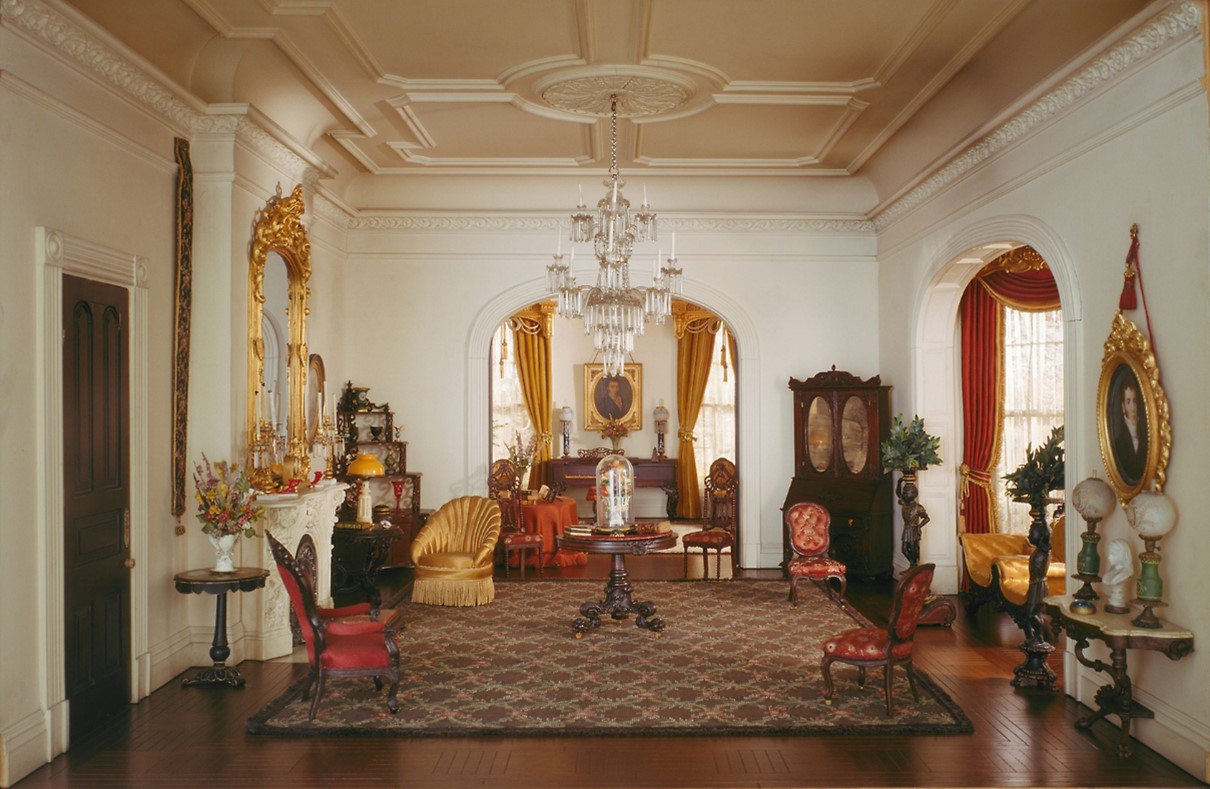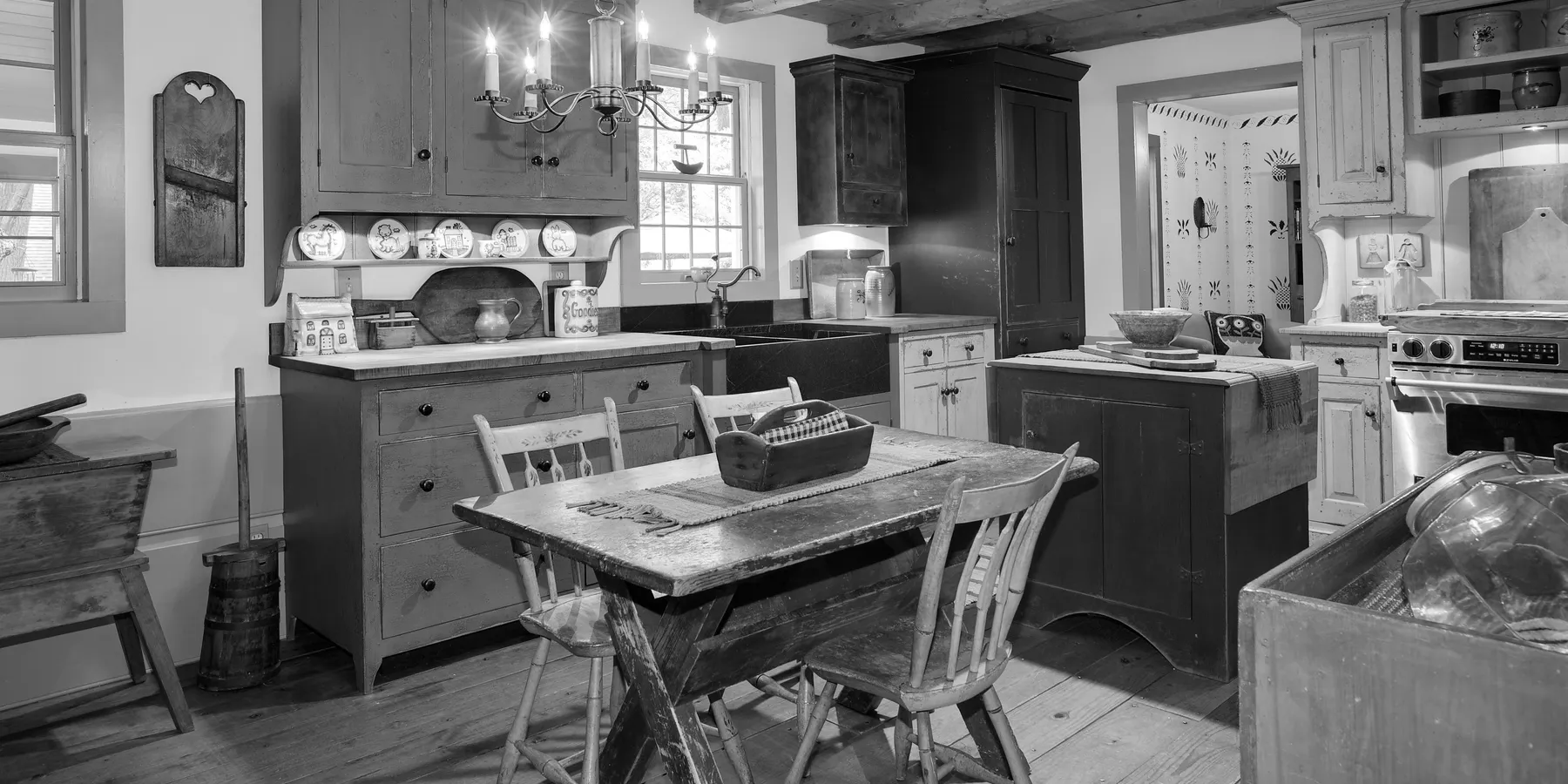Abstract
As products of the Enlightenment and Western European civilization, museums must acknowledge their ties to colonialism, empire, White supremacy, and structural exclusion. Museum practices that facilitate visitors’ reflection on legacies of oppression encourage social and cultural growth and express organizational commitment to ethics and justice. This article discusses how the Art Institute of Chicago has reckoned with its own colonial legacies to begin dismantling them. Practices of diversity, equity, and antiracism in the museum field can inform how health professionals orient themselves to their professions’ roles in the Holocaust.
Interiors of the 17th to the 20th Centuries
Millions of visitors to the Art Institute of Chicago (AIC) have experienced the Thorne Miniature Rooms, nestled in a custom-built gallery just off the grand staircase, which offer some of the AIC’s most iconic and popular works of art. Every day, this gallery’s narrow halls are packed with visitors of all ages who look carefully, curiously, and cautiously at the collection’s 68 intricately crafted dioramas. Conceived by Mrs James Ward Thorne (né Narcissa Niblack Thorne), the Miniature Rooms were intended to serve as educational models, demonstrating period-specific interior decor and design.1 Mrs Thorne had expertise in the decorative arts and collected miniatures for years throughout Europe and the United States. She directed a team of master craftspeople, artists, and architects to create European and American interiors from the 17th to the 20th centuries, a traditional Japanese interior, and a traditional Chinese interior.1 They were exhibited globally prior to being gifted to the AIC by Mrs Thorne in 1941.1
One source of visitors’ delight and curiosity is likely the rooms’ unique capacity to inspire storytelling: the way the rooms are placed and illuminated makes them feel like tiny stage sets, poised for action. Take the Virginia Kitchen, 18th Century. The door is flung wide open, sunlight streaming in as though the house’s inhabitants left the scene just as we come upon it. A little doll and a ball at the far right on the floor suggest a small child had just been playing with them. A fresh pie (maybe cherry?), waiting to be eaten, sits on the table by a plate and knife. The family’s simple, perhaps joyful, life is easy for a viewer to imagine.
Upon closer inspection, however, something becomes more apparent, even uncomfortable: the rooms predominantly tell stories from homes where White people are protagonists. The Georgia Double Parlor, c 1850—with its beautifully upholstered chairs, lavish curtains, chandelier, and crown molding—models decorative schemes from the 1939 film adaptation of Gone With the Wind.2 Viewers might imagine ladies and gentlemen taking tea and discussing pleasantries, and they might also envision Black people serving them, since the diorama invites us to picture a US southern plantation manor home. Although Mrs Thorne’s intention was to catalog taste, style, and design through impeccable craftsmanship, we must also consider how the rooms represent legacies of injustice, racism, and colonization. The Thorne Miniature Rooms, though beautiful and imaginative, are not neutral, empty scenes—they come with predetermined, period-specific histories, showing us a past that benefitted some and deeply wronged others.
Figure. A30: Georgia Double Parlor, c 1850, 1937-1940, designed by Mrs James Ward Thorne

The Art Institute of Chicago®. Gift of Mrs James Ward Thorne.
Tiny Rooms, Entire Museums
In their seeming neutrality and telling of exclusionary histories, the Thorne Miniature Rooms can be regarded as microcosms of museums proper, for Western museums are tied to legacies of colonialism and White supremacy. Many major art and natural history museums in Europe and the United States were founded in the late 19th and early 20th centuries, mostly by White men.3,4,5,6 Museums were established with the presumably generous aim of educating the public while collecting and exhibiting “the best of the best.”7 For art museums, this meant acquiring works by established White men from Europe. This commitment, of course, led to a structural, institutionalized exclusion. Additionally, many museums were built in the neoclassical architectural style reminiscent of ancient Greece and Rome to resemble these so-called pinnacles of Western civilization.8 Museums, as such, were not only founded by the powerful and privileged, but also meant to occupy higher intellectual ground by seeking to educate the masses on relevance and beauty.
As a world-renowned home to a dazzling collection in all media from all over the world, the AIC is not exempt from these legacies. Founded in 1879, the museum moved to its current home in downtown Chicago in 1893.8 The iconic Michigan Avenue building, designed by Shepley, Rutan, and Coolidge in the Beaux Arts style (named for the École des Beaux-Arts in France) combined architectural styles from the Italian Renaissance with Greek and Roman decorative motifs.8,9 Many European museums, cultural centers, and administrative buildings erected during this period were designed in this style.9 The building is one of the only surviving structures from the World’s Columbian Exhibition of 1893, which similarly utilized the Beaux Arts style to create a civic vision and celebrate the arrival of Christopher Columbus to the Americas in 1492 and to establish Chicago as a world-class city.8 As such, the AIC’s presence was inextricably tied to the celebration of empire building and colonization. Recognizing these ties to exclusionary histories, the AIC has taken important steps to acknowledge them and embrace an inclusive and equitable future as a civic and global institution.
Looking Back to Move Forward
The AIC has made clear that it understands its obligation not only to the public it serves but also to the museum field at large. In June 2020, for example, in response to domestic and international Black Lives Matter activism, James Rondeau, president and Eloise W. Martin Director of the AIC, articulated a vision of the museum’s future:
As we reflect on our past, we are accountable for our museum’s legacy of white privilege and exclusion, not only in the representation of artists of color in our collection but also of those in our community who have historically felt unwelcome in our spaces. That legacy is antithetical to the museum we aspire to be. We have been investing resources, and will extend those commitments, to create meaningful change.10
These commitments have extended—and must necessarily extend—to all areas and all levels of leadership and not just to the work displayed or collected. In undertaking a massive overhaul of the museum’s internal workings and external initiatives, the AIC is attempting to create a pervasive attitude and culture of equity, so that antiracism dialogues and decolonizing attitudes will be consistent, expected, and encouraged.
Additionally, in 2019, the AIC made an official acknowledgement to recognize that the museum occupies Indigenous lands:
The Art Institute of Chicago is located on the traditional homelands of the Council of the Three Fires: the Ojibwe, Odawa, and Potawatomi Nations. Many other tribes such as the Miami, Ho-Chunk, Menominee, Sac, and Fox also called this area home. The region has long been a center for Indigenous people to gather, trade, and maintain kinship ties. Today, one of the largest urban American Indian communities in the United States resides in Chicago. Members of this community continue to contribute to the life of this city and to celebrate their heritage, practice traditions, and care for the land and waterways.11
This statement has been followed up by AIC leadership’s commitment to work actively with Indigenous populations that reside in the Chicagoland area—in particular, through a partnership with the American Indian Center of Chicago and through open dialogues with the Department of the Arts of the Americas, the curatorial department that displays Native American art at the AIC.
With respect to daily museum practice, the AIC’s Learning and Public Engagement (LPE) Department works to develop learning strategies and enact practices that motivate and promote access, inclusivity, and equity. Because this department interacts the most with the public and concerns itself with visitor experience, its goal is to create spaces in the museum where visitors will feel safe, engaged, and welcome. It is also LPE’s prerogative to advocate for all visitors to the museum regardless of ability, race, ethnicity, or personal background. LPE aims to enact these values not only through tours and talks within the galleries, but also through large-scale programs, civic-minded initiatives, and exhibition planning.
Although a lot of work, learning, and unlearning remain to be done, the AIC continues to take powerful steps toward achieving equity in the museum profession, aspiring to the “highest ethical standards and practices” across the board.12
From Museums to Health Care
Museums and museum holdings help frame historical and cultural narratives that visitors draw upon during their encounters with art—miniature and monumental—and in their everyday lives, perhaps to help make sense of their or their ancestors’ roles in perpetrating or experiencing oppression. Museum professionals are obliged to model and advocate for antiracist thinking and decolonization of museum spaces and practices, just as health care professionals must find ways to orient themselves to their professions’ earlier mistakes or atrocities or their own complicity in them. During the Holocaust, for example, eugenicists, particularly Nazi clinicians, wrought damage that ramifies and persists today. Like museums, health professions must reckon with their pasts in perpetuating injustice. Also like museums, health care organizations occupy positions of power and authority and are widely regarded as keepers of collective knowledge and histories. Our professional and organizational roles as social and cultural stewards of public and common goods of humanity and advocates for equity in the present and future demand reconciliation with our pasts.
References
-
O’Connor SM. The Thorne Rooms at the Art Institute of Chicago. In the Garden City. January 6, 2019. Accessed July 6, 2020. https://inthegardencity.com/2019/01/06/the-thorne-rooms-at-the-art-institute-of-chicago-by-s-m-oconnor/
-
The Art Institute of Chicago. Thorne Miniature Rooms. Accessed July 3, 2020. https://www.artic.edu/highlights/12/thorne-miniature-rooms
- Kohlstedt SG. “Thoughts in things”: modernity, history, and North American museums. Isis. 2005;96(4):586-601.
- Molina S. Sustaining the lives of art objects. AMA J Ethics. 2019;21(5):E450-E454.
-
Stanard MG. Curators and colonial control: Belgium’s museums of empire. In: Selling the Congo: A History of European Pro-empire Propaganda and the Making of Belgian Imperialism. University of Nebraska Press; 2011:89-134.
-
Umolu Y. On the limits of care and knowledge: 15 points museums must understand to dismantle structural injustice. Artnet News. June 25, 2020. Accessed September 30, 2020. https://news.artnet.com/opinion/limits-of-care-and-knowledge-yesomi-umolu-op-ed-1889739
- King L. Rhetorics in a museum space: connecting exhibit spaces, contexts, and audiences. JAC. 2013;33(3/4):671-688.
-
Dillon D. Art Institute of Chicago. Encyclopedia of Chicago. Accessed May 18, 2020. http://www.encyclopedia.chicagohistory.org/pages/79.html
-
ThoughtCo. Discover the beauty of Beaux arts: exuberant and classical architecture inspired by France. Accessed November 11, 2020. https://www.thoughtco.com/what-is-beaux-arts-architecture-178195
-
Rondeau J. Our commitment to racial justice and equity. Art Institute of Chicago. Accessed July 3, 2020. https://www.artic.edu/articles/841/our-commitment-to-racial-justice-and-equity
-
Art Institute of Chicago. Land acknowledgment. Accessed May 23, 2020. https://www.artic.edu/about-us/land-acknowledgment
-
Art Institute of Chicago. Mission and history. Accessed May 23, 2020. https://www.artic.edu/about-us/mission-and-history




